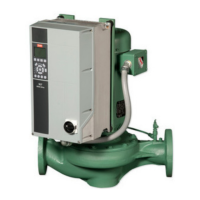Taco® SKV
8
302-365, Effective: June 5, 2017
© 2017 Taco, Inc.
pads must be used under the legs and monitored as pipe
hangers are adjusted to ensure the pump flanges are not
supporting the piping. Bolting to the floor or housekeep-
ing pad is not recommended. If the stanchions are bolted
down the bolts must be isolated from the stanchion or
inertia base and flexible pipe connectors used (Figure 7-
10).
Figure 7-10: With Stanchion Plates
An installation with stanchion plates for seismically active
regions is illustrated in Figure 7-11. Seismically rated iso-
lation pads or snubbers with bolts isolated from the stan-
chion plates are installed to restrain the pump during a
seismic event. Pipe hangers carry the weight of the
equipment as seismic components are designed only to
restrain the equipment during a seismic event.
Figure 7-11: Installation in Seismically Active
Region
In systems utilizing grooved pipe, flange adapter locking
devices or welded flanges at the pump should be used to
prevent the possibility of pipe mounted pumps rotating in
the piping (Figure 7-12).
Figure 7-12: Mounting in Grooved Pipe Systems
DO NOT support the unit by the motor eye bolts
(Figure 7-13) or by any other part of the motor.
Figure 7-13: Motor Lifting Hook Supported
Connecting the pump to a permanent rigid base
(Figure 7-14) is not recommended unless isolated from
the piping by flexible connectors and the base isolated
from the building structure on an inertia base. (Figure 7-
14 is generally acceptable when using plastic piping.)
Figure 7-14: Mounted on Rigid Base without
Flexible Connectors
NOTE: The pump should not be rigidly attached to the base/pad structure unless flexible couplings are used.

